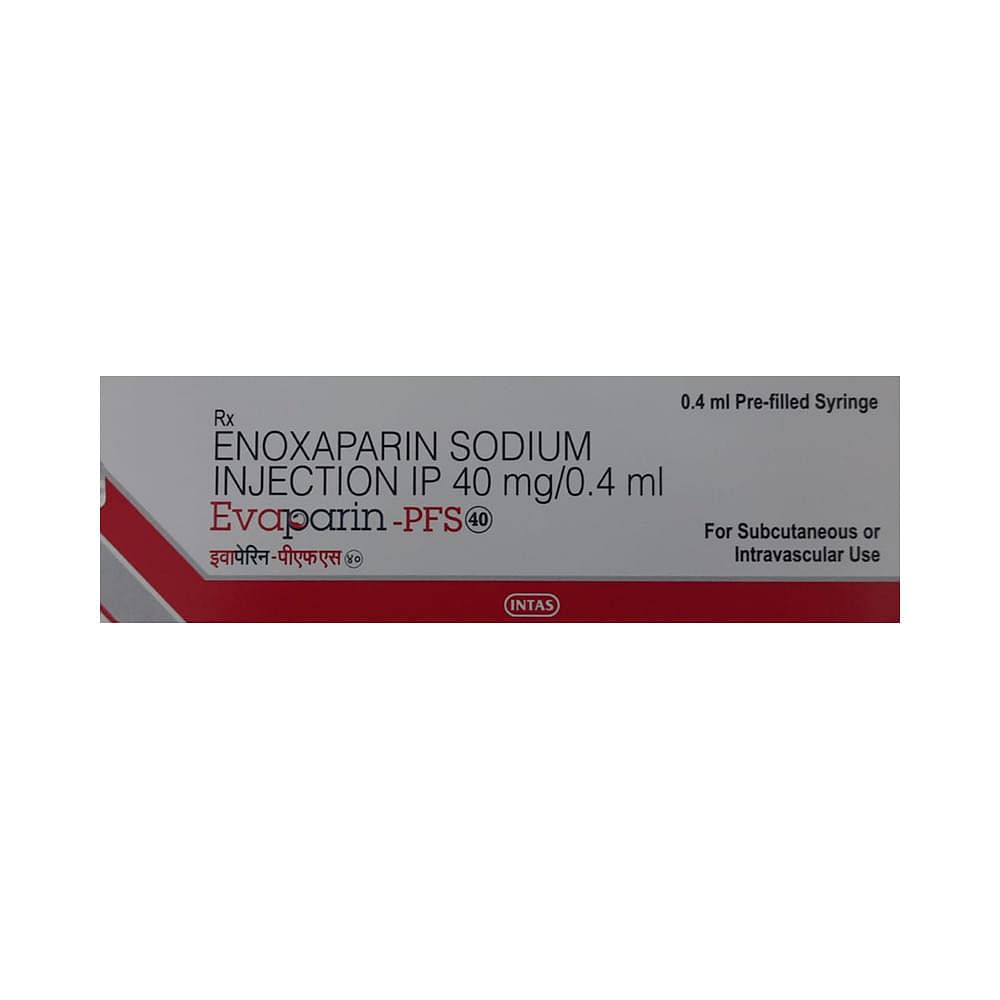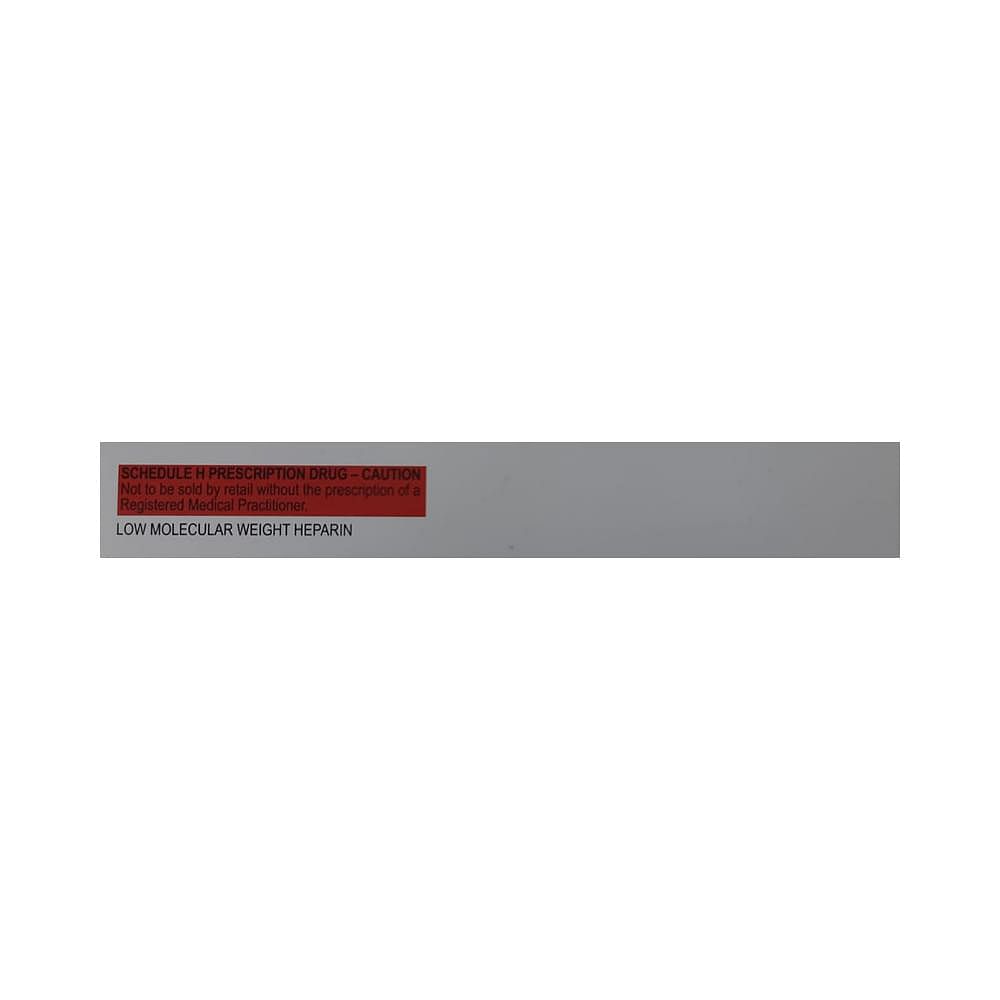


Evaparin -PFS 40 Injection
Manufacturer
Intas Pharmaceuticals Ltd
Salt Composition
Enoxaparin (40mg)
Key Information
Short Description
Evaparin -PFS 40 Injection is an anticoagulant used to prevent and treat harmful blood clots.
Dosage Form
Injection
Introduction
Evaparin -PFS 40 Injection is injected under the skin by a doctor or nurse. It should not be injected into a muscle. The dose and length of treatment are based on your medical condition, your response to the medicine, and what you are being treated for. It may also be based on your age and weight. It is important to keep using this medicine even if you do not notice any symptoms because it is preventing future harm. If you stop taking it, you could get a blood clot. While taking this medicine you should avoid doing things that increase your risk of bleeding or injury.
Directions for Use
Your doctor or nurse will give you this medicine. Kindly do not self-administer.
Safety Information
Side Effects
Injection site pain Bleeding Headache Increased blood platelets Breathing problems Edema Anemia Fever Diarrhea Increased liver enzymes
Alcohol Warning
It is not known whether it is safe to consume alcohol with Evaparin -PFS 40 Injection. Please consult your doctor.
Breastfeeding Warning
Evaparin -PFS 40 Injection is probably safe to use during breastfeeding. Limited human data suggests that the drug does not represent any significant risk to the baby.
Pregnancy Warning
Evaparin -PFS 40 Injection is generally considered safe to use during pregnancy. Animal studies have shown low or no adverse effects to the developing baby; however, there are limited human studies.
Interacting Medicines
Benazepril Candesartan Captopril Clopidogrel
How it works
Evaparin -PFS 40 Injection is an anticoagulant. It works by inactivating certain blood-clotting proteins. This prevents the formation of blood clots and prevents blockages in the blood vessels of the body.
Quick Tips
You have been prescribed Evaparin -PFS 40 Injection for the treatment and prevention of blood clots. Evaparin -PFS 40 Injection increases your risk of bleeding. Be careful while shaving, using sharp objects or cutting fingernails or toenails. Inform your doctor if you are also taking other medicines that increase the bleeding risk like aspirin and NSAIDs. Inform your doctor if there is bleeding from gums, nose or wounds that lasts more than 15 minutes or if blood appears in your urine, stool or vomit. Do not stop taking the medication suddenly without talking to your doctor.
Frequently asked questions
How do you administer Evaparin -PFS 40 Injection?
Evaparin -PFS 40 Injection is an injectable medication administered subcutaneously. Before administering, ensure you understand the prescribed dosage and follow the instructions provided by your prescribing physician. Gently pinch the skin of your abdomen between your thumb and index finger to create a fold. After cleaning the area with alcohol wipes or prescribed solution, hold the syringe like a pencil and insert the needle fully into the skin fold. Inject the medication as instructed and discard the syringe after use according to your physician's instructions. Always consult your prescribing physician for any questions or concerns regarding medication administration.
What are the conditions where I should be cautious before taking Evaparin -PFS 40 Injection?
It is crucial to provide accurate medical history to your doctor prior to starting Evaparin -PFS 40 Injection. Inform your healthcare provider if you have pre-existing heart valve issues, gastric ulcers, high blood pressure, diabetes, or kidney problems. Additionally, disclose any past reactions to heparin or recent stroke, brain or spinal surgeries. These conditions may increase the likelihood of side effects and complications. Always seek guidance from your physician and follow their instructions precisely.
How to store Evaparin -PFS 40 Injection injections?
Store Evaparin -PFS 40 Injection at 25°C (77°F) and keep it away from freezing temperatures. Do not exceed storing the multi-dose vials for more than 28 days after opening them initially. Any signs of particulate matter, abnormal color changes in the solution, or damage to the syringe should be immediately discarded as per the instructions provided in the medication package leaflet. Before administering this medication, consult the accompanying drug information and seek clarification from a pharmacist if necessary.
Can Evaparin -PFS 40 Injection be used during a heart attack?
Evaparin -PFS 40 Injection is generally prescribed to patients who are experiencing chest pain or having a heart attack. It is administered in conjunction with standard medical treatment for the patient after initial intervention. The medication helps prevent blood clot formation by thinning the blood, thus reducing the risk of further complications.
Is it ok to inject air bubbles in Evaparin -PFS 40 Injection?
Yes, it is acceptable to inject any remaining air bubbles into the injection site. Removing these bubbles may lead to a reduction of the medication dosage and alter its prescribed application.


